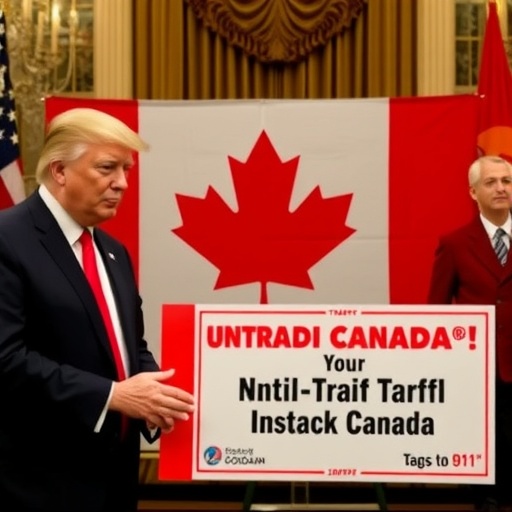Trump Hits Canada with 10% Tariff Boost Over Ontario’s Anti-Tariff Ad Stunt, Cancels ASEAN Summit Meeting
In a dramatic escalation of U.S.-Canada trade tensions, President Donald Trump has imposed an additional 10% tariff on all Canadian imports, directly retaliating against a provocative television advertisement aired by the Ontario government. The ad, which repurposed words from former U.S. President Ronald Reagan to criticize American tariff policies, was branded a ‘hostile act’ by Trump, prompting him to cancel a planned bilateral meeting with Canadian Prime Minister Mark Carney at the upcoming ASEAN summit. This move risks reigniting a trade war that has simmered since the renegotiation of NAFTA into the USMCA agreement.
Ontario’s Reagan-Inspired Ad Ignites Cross-Border Firestorm
The controversy erupted last week when Ontario, Canada’s most populous province and a key economic powerhouse, launched a 30-second TV spot aimed at U.S. audiences. Titled ‘Echoes of Freedom,’ the advertisement featured archival footage of Ronald Reagan delivering his famous 1987 speech against protectionism, where he warned that tariffs ‘tax the American people’ and stifle global trade. Ontario Premier Doug Ford narrated the ad, overlaying Reagan’s words with visuals of shuttered factories in Windsor and frustrated auto workers, implicitly slamming Trump’s protectionist agenda.
‘We in Ontario believe in free markets, just like President Reagan did,’ Ford stated in a press release accompanying the ad’s debut on major networks like CNN and Fox News. The province, which shares a 2,000-mile border with the U.S. and relies heavily on cross-border trade—exporting over $100 billion in goods annually to American markets—positioned the campaign as a defense of mutual economic interests. However, the ad’s timing, just weeks before the ASEAN summit in Jakarta, Indonesia, caught White House officials off guard.
Trade experts note that Ontario’s strategy was calculated to appeal to U.S. conservatives who revere Reagan. ‘It’s a clever jab, using an icon of the Republican Party to underscore the irony of current policies,’ said Dr. Elena Vasquez, an international trade analyst at the Brookings Institution. But the backlash was swift. Within hours of the ad going viral on social media, racking up over 5 million views, Trump took to his Truth Social platform to denounce it as ‘fake news propaganda from socialist Canada.’
Trump’s Tariff Retaliation Targets Key Canadian Exports
President Trump’s response came during a fiery press conference at the White House Rose Garden on Tuesday afternoon, where he announced the immediate imposition of a 10% surcharge on top of existing tariffs for all imports from Canada. This affects a broad spectrum of goods, from automobiles and aluminum to lumber and maple syrup, potentially adding billions to the cost of trade between the two nations.
‘Canada thought they could lecture America on trade? Not on my watch,’ Trump declared, flanked by U.S. Trade Representative Katherine Tai and Commerce Secretary Gina Raimondo. ‘This ad is a hostile act against our sovereignty. We’re adding 10% tariffs starting next week—no exceptions. And tell Prime Minister Carney that our ASEAN summit meeting is off. Canada needs to learn respect.’
The new tariffs build on previous measures. Under the USMCA, which Trump negotiated in 2018, baseline tariffs on most Canadian goods were eliminated, but targeted duties on steel (25%) and aluminum (10%) remain from earlier disputes. This 10% blanket increase could raise the effective rate on sensitive sectors like automotive parts—where Ontario supplies 20% of U.S. imports—to over 15%, according to estimates from the U.S. Chamber of Commerce.
Statistics underscore the stakes: In 2023, bilateral trade between the U.S. and Canada totaled $1.2 trillion, with Canada as America’s largest trading partner. Ontario alone contributes about 40% of Canada’s exports to the U.S., including $50 billion in vehicles and parts. Economists warn that the tariffs could inflate U.S. car prices by 2-5%, hitting consumers in border states like Michigan and New York hardest.
- Key Affected Sectors: Automotive (e.g., Ford and GM plants in Ontario), Energy (oil sands exports), Agriculture (dairy and grains).
- Projected Cost: Up to $12 billion annually in additional duties, per Canadian Chamber of Commerce data.
- U.S. Impact: Higher costs for 2.5 million American jobs tied to Canadian supply chains.
Canadian officials were quick to condemn the move. Prime Minister Mark Carney, speaking from Ottawa, called the tariffs ‘unwarranted and escalatory,’ vowing to challenge them through the USMCA dispute mechanism. ‘This isn’t just about an ad—it’s about undermining years of progress in North American trade,’ Carney said.
Canceled ASEAN Summit Talks Signal Deeper Diplomatic Rift
The decision to skip the bilateral meeting at the ASEAN summit, scheduled for November 15-17 in Jakarta, marks a significant chill in U.S.-Canada relations. The summit, hosted by the Association of Southeast Asian Nations, was intended as a platform for Trump and Carney to discuss supply chain resilience amid global tensions with China. Now, with the meeting off, Canadian diplomats are scrambling to salvage agenda items through multilateral channels.
ASEAN summits have historically served as neutral grounds for North American leaders to iron out differences away from domestic pressures. In 2022, a similar gathering led to a joint U.S.-Canada initiative on critical minerals, vital for electric vehicle batteries. ‘Canceling this is like throwing away a golden opportunity for collaboration,’ noted Ambassador David MacNaughton, former Canadian envoy to the U.S. ‘It plays into narratives of American isolationism.’
Behind the scenes, sources familiar with the matter reveal that White House advisors urged Trump to reconsider, citing potential blowback on U.S. interests in the Indo-Pacific. ASEAN represents a $3 trillion market, and strong U.S.-Canada alignment there bolsters America’s position against Chinese influence. Yet Trump doubled down, tweeting that ‘Canada must apologize first’ for the ad.
The diplomatic snub extends beyond ASEAN. Reports indicate that Carney’s planned visit to Washington for G7 preparatory talks may also be in jeopardy, further straining ties forged during the pandemic-era cooperation on vaccines and border reopenings.
Economic Ripples Hit Industries on Both Sides of the Border
As the dust settles from Trump’s announcement, businesses are bracing for turbulence. In Ontario, the auto sector—centered in the Golden Horseshoe region from Toronto to Windsor—is sounding alarms. General Motors and Stellantis, which operate major assembly plants in the province, warned of production delays and job losses. ‘These tariffs disrupt just-in-time manufacturing that’s the backbone of our industry,’ said Unifor union president Jerry Diaz, representing 40,000 Ontario autoworkers.
On the U.S. side, retailers like Walmart and Home Depot, heavy importers of Canadian lumber for housing construction, predict price hikes. The National Association of Home Builders estimates that lumber tariffs could add $9,000 to the cost of a new single-family home, exacerbating the housing crisis. Meanwhile, energy markets are volatile; Canada’s oil exports via pipelines like Keystone XL, which Trump championed, now face compounded duties that could redirect flows to Asia.
Broader economic data paints a precarious picture. The Bank of Canada projects that a full-blown trade spat could shave 0.5% off GDP growth in 2025, while U.S. inflation might tick up by 0.2%, per Federal Reserve models. Small businesses, often overlooked in these disputes, stand to suffer most. Take Tim Hortons, the iconic Canadian chain with 5,000 U.S. locations—its coffee bean imports from Ontario could see costs rise 10%, potentially leading to menu price adjustments.
- Short-Term Effects: Supply chain bottlenecks, with trucking firms along the Ambassador Bridge reporting 20% delays already.
- Longer-Term Risks: Possible Canadian countermeasures, like duties on U.S. tech exports or agricultural goods.
- Consumer Impact: Everyday items like beer (Ontario’s craft breweries supply U.S. markets) and winter gear could cost 5-10% more.
Analysts from RBC Economics highlight the irony: Both nations’ economies are intertwined, with 75% of Canadian exports destined for the U.S. ‘This tit-for-tat could undo the USMCA’s gains, pushing us back to the pre-1994 NAFTA era of uncertainty,’ said senior economist Robert Hogue.
Trade Experts Forecast Prolonged Standoff and Global Repercussions
Looking ahead, the path to resolution appears fraught. Trump’s tariff hike, effective November 1, includes a 90-day review period, during which negotiations could resume if Canada retracts the ad or offers concessions. However, Ontario’s Ford government shows no signs of backing down, with plans to expand the campaign digitally across platforms like YouTube and TikTok.
International observers are watching closely, fearing spillover effects. The European Union, already navigating its own tariff battles with the U.S., has expressed concern that North American discord could weaken global trade norms under the WTO. In Asia, ASEAN nations worry that a distracted U.S. might cede ground to China’s Belt and Road initiatives.
For U.S. consumers and businesses, the implications are stark: Higher costs amid cooling inflation, potential job shifts in manufacturing, and strained alliances at a time when unity against geopolitical threats is crucial. Prime Minister Carney has signaled willingness for talks, but only if tariffs are paused. ‘We value our partnership with America, but not at the expense of our principles,’ he affirmed.
As winter approaches, the U.S.-Canada border—once a symbol of seamless integration—now looms as a flashpoint. Whether this escalates into a full trade war or cools through backchannel diplomacy remains to be seen, but one thing is clear: The echoes of Reagan’s words have reverberated far beyond Ontario’s screens, reshaping the contours of North American commerce.









